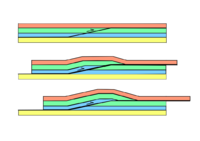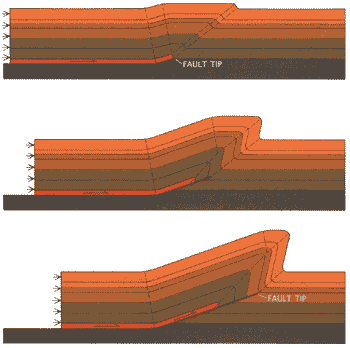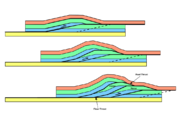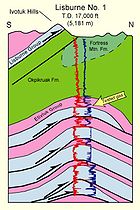
Thrust fault
Encyclopedia

Force
In physics, a force is any influence that causes an object to undergo a change in speed, a change in direction, or a change in shape. In other words, a force is that which can cause an object with mass to change its velocity , i.e., to accelerate, or which can cause a flexible object to deform...
.
Thrust geometry and nomenclature




Reverse faults
Thrust faults typically have low dipStrike and dip
Strike and dip refer to the orientation or attitude of a geologic feature. The strike line of a bed, fault, or other planar feature is a line representing the intersection of that feature with a horizontal plane. On a geologic map, this is represented with a short straight line segment oriented...
angles. A high-angle thrust fault is called a reverse fault. The difference between a thrust fault and a reverse fault is in their influence. A reverse fault occurs primarily across lithological units where as a thrust usually occurs within or at a low angle to lithological units. It is often hard to recognize thrusts because their deformation and dislocation can be difficult to detect when they occur within the same rocks without appreciable offset of lithological contacts.
If the angle of the fault plane is low (generally less than 20 degrees from the horizontal) and the displacement of the overlying block is large (often in the kilometer range) the fault is called an overthrust. Erosion can remove part of the overlying block, creating a fenster (or window
Window (geology)
thumb|right|350px|Schematic overview of a thrust system. The [[fault |hanging wall block]] is called a [[nappe]]. If an [[erosion]]al hole is created in the nappe that is called a window. A [[klippe]] is a solitary outcrop of the nappe in the middle of autochthonous material.A tectonic window...
) when the underlying block is only exposed in a relatively small area. When erosion removes most of the overlying block, leaving only island-like remnants resting on the lower block, the remnants are called klippen (singular klippe
Klippe
thumb|right|350px|Schematic overview of a thrust system. The shaded material is called a [[nappe]]. The erosional hole is called a [[window |window or fenster]]. The klippe is the isolated block of the nappe overlying autochthonous material....
).
Blind thrust faults
If the fault plane terminates before it reaches the Earth's surface, it is referred to as a blind thrust fault. Because of the lack of surface evidence, blind thrust faults are difficult to detect until they rupture. The destructive 1994 quake in Northridge, CaliforniaNorthridge earthquake
The Northridge earthquake was a massive earthquake that occurred on January 17, 1994, at 04:31 Pacific Standard Time in Reseda, a neighborhood in the city of Los Angeles, California, lasting for about 10–20 seconds...
was caused by a previously-undiscovered blind thrust fault.
Because of their low dip
Strike and dip
Strike and dip refer to the orientation or attitude of a geologic feature. The strike line of a bed, fault, or other planar feature is a line representing the intersection of that feature with a horizontal plane. On a geologic map, this is represented with a short straight line segment oriented...
, thrusts are also difficult to appreciate in mapping, where lithological offsets are generally subtle and stratigraphic repetition difficult to detect especially in peneplanated
Peneplain
A peneplain is a low-relief plain representing the final stage of fluvial erosion during times of extended tectonic stability. The existence of peneplains, and peneplanation as a geomorphological process, is not without controversy, due to a lack of contemporary examples and uncertainty in...
areas.
Fault-bend folds
Thrust faults, particularly those involved in thin-skinned style of deformation, have a so-called ramp-flat geometry. Thrusts mostly propagate along zones of weakness within a sedimentary sequence, such as mudstoneMudstone
Mudstone is a fine grained sedimentary rock whose original constituents were clays or muds. Grain size is up to 0.0625 mm with individual grains too small to be distinguished without a microscope. With increased pressure over time the platey clay minerals may become aligned, with the...
s or salt layers, these parts of the thrust are called flats. If the effectiveness of the decollement
Decollement
Décollement is a gliding plane between two rock masses. In French, "décoller" means "to detach from" or "to rip off" and was first used by geologists studying the structure of the Swiss Jura Mountains, but is also known as a detachment zone. This is a structure of strata owing to deformation,...
becomes reduced the thrust will tend to cut up the section to a higher stratigraphic level, until it reaches another effective decollement where it can continue as bedding parallel flat. The part of the thrust linking the two flats is known as a ramp and typically forms at an angle of about 15°-30° to the bedding. Continued displacement on a thrust over a ramp produces a characteristic fold geometry known as a ramp anticline or, more generally, as a fault-bend fold.
Fault-propagation folds
Fault-propagation folds form at the tip of a thrust fault where propagation along the decollement has ceased but displacement on the thrust behind the fault tip is continuing. The continuing displacement is accommodated by formation of an asymmetric anticline-syncline fold pair. As displacement continues the thrust tip starts to propagate along the axis of the syncline. Such structures are also known as tip-line folds. Eventually the propagating thrust tip may reach another effective decollement layer and a composite fold structure will develop with characteristics of both fault-bend and fault-propagation folds.Thrust duplex
Duplexes occur where there are two decollement levels close to each other within a sedimentary sequence, such as the top and base of a relatively strong sandstoneSandstone
Sandstone is a sedimentary rock composed mainly of sand-sized minerals or rock grains.Most sandstone is composed of quartz and/or feldspar because these are the most common minerals in the Earth's crust. Like sand, sandstone may be any colour, but the most common colours are tan, brown, yellow,...
layer bounded by two relatively weak mudstone layers. When a thrust that has propagated along the lower detachment, known as the floor thrust, cuts up to the upper detachment, known as the roof thrust, it forms a ramp within the stronger layer. With continued displacement on the thrust, higher stresses are developed in the footwall of the ramp due to the bend on the fault. This may cause renewed propagation along the floor thrust until it again cuts up to join the roof thrust. Further displacement then takes place via the newly created ramp. This process may repeat many times, forming a series of fault bounded thrust slices known as imbricates or horses, each with the geometry of a fault-bend fold of small displacement. The final result is typically a lozenge shaped duplex.
Most duplexes have only small displacements on the bounding faults between the horses and these dip away from the foreland. Occasionally the displacement on the individual horses is greater, such that each horse lies more or less vertically above the other, this is known as an antiformal stack or imbricate stack. If the individual displacements are greater still, then the horses have a foreland dip.
Duplexing is a very efficient mechanism of accommodating shortening of the crust by thickening the section rather than by folding and deformation.
Tectonic environment
Large overthrust faults occur in areas that have undergone great compressional forces.These conditions exist in the orogenic belts
Orogeny
Orogeny refers to forces and events leading to a severe structural deformation of the Earth's crust due to the engagement of tectonic plates. Response to such engagement results in the formation of long tracts of highly deformed rock called orogens or orogenic belts...
that result from either two continental
Continental crust
The continental crust is the layer of igneous, sedimentary, and metamorphic rocks which form the continents and the areas of shallow seabed close to their shores, known as continental shelves. This layer is sometimes called sial due to more felsic, or granitic, bulk composition, which lies in...
tectonic
Tectonic Plates
Tectonic Plates is a 1992 independent Canadian film directed by Peter Mettler. Mettler also wrote the screenplay based on the play by Robert Lepage. The film stars Marie Gignac, Céline Bonnier and Robert Lepage.-Plot summary:...
collisions or from subduction zone accretion.
The resultant compressional forces produce mountain
Mountain
Image:Himalaya_annotated.jpg|thumb|right|The Himalayan mountain range with Mount Everestrect 58 14 160 49 Chomo Lonzorect 200 28 335 52 Makalurect 378 24 566 45 Mount Everestrect 188 581 920 656 Tibetan Plateaurect 250 406 340 427 Rong River...
ranges. The Himalayas
Himalayas
The Himalaya Range or Himalaya Mountains Sanskrit: Devanagari: हिमालय, literally "abode of snow"), usually called the Himalayas or Himalaya for short, is a mountain range in Asia, separating the Indian subcontinent from the Tibetan Plateau...
, the Alps
Alps
The Alps is one of the great mountain range systems of Europe, stretching from Austria and Slovenia in the east through Italy, Switzerland, Liechtenstein and Germany to France in the west....
, and the Appalachians are prominent examples of compressional orogenies with numerous overthrust faults.
Thrust faults occur in the foreland basin which occur marginal to orogenic belts. Here, compression does not result in appreciable mountain building, which is mostly accommodated by folding and stacking of thrusts. Instead thrust faults generally cause a thickening of the stratigraphic section.
Foreland basin thrusts also usually observe the ramp-flat geometry, with thrusts propagating within units at a very low angle "flats" (at 1-5 degrees) and then moving up-section in steeper ramps (at 5-20 degrees) where they offset stratigraphic units. Identifying ramps where they occur within units is usually problematic.
Thrusts and duplexes are also found in accretionary wedge
Accretionary wedge
An accretionary wedge or accretionary prism is formed from sediments that are accreted onto the non-subducting tectonic plate at a convergent plate boundary...
s in the ocean trench margin of subduction zones, where oceanic sediments are scraped off the subducted plate and accumulate. Here, the accretionary wedge must thicken by up to 200% and this is achieved by stacking thrust fault upon thrust fault in a melange
Mélange
In geology, a mélange is a large-scale breccia, a mappable body of rock characterized by a lack of continuous bedding and the inclusion of fragments of rock of all sizes, contained in a fine-grained deformed matrix. The mélange typically consists of a jumble of large blocks of varied lithologies...
of disrupted rock, often with chaotic folding. Here, ramp flat geometries are not usually observed because the compressional force is at a steep angle to the sedimentary layering.
History
Thrust faults were unrecognised until the work of Escher, Heim and Bertrand in the Alps working on the Glarus ThrustGlarus thrust
The Glarus thrust is a major thrust fault in the Alps of eastern Switzerland. Along the thrust the Helvetic nappes were thrusted more than 100 km to the north over the external Aarmassif and Infrahelvetic complex...
, Lapworth, Peach and Horne working on parts of the Moine Thrust
Moine Thrust Belt
The Moine Thrust Belt is a linear geological feature in the Scottish Highlands which runs from Loch Eriboll on the north coast 190 km south-west to the Sleat peninsula on the Isle of Skye...
Scotland
Scotland
Scotland is a country that is part of the United Kingdom. Occupying the northern third of the island of Great Britain, it shares a border with England to the south and is bounded by the North Sea to the east, the Atlantic Ocean to the north and west, and the North Channel and Irish Sea to the...
, Tornebohm in the Scandinavian Caledonides and McConnell in the Canadian Rockies. The realisation that older strata could, via faulting, be found above younger strata, was arrived at more or less independently by geologists in all these areas during the 1880s. Geikie
Archibald Geikie
Sir Archibald Geikie, OM, KCB, PRS, FRSE , was a Scottish geologist and writer.-Early life:Geikie was born in Edinburgh in 1835, the eldest son of musician and music critic James Stuart Geikie...
in 1884 coined the term thrust to describe this special set of faults.
- "By a system of reversed faults, a group of strata is made to cover a great breadth of ground and actually to overlie higher members of the same series. The most extraordinary dislocations, however, are those to which for distinction we have given the name of Thrust-planes. They are strictly reversed faults, but with so low a hade that the rocks on their upthrown side have been, as it were, pushed horizontally forward." Archibald Geikie 1884, Nature.

